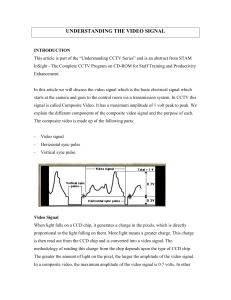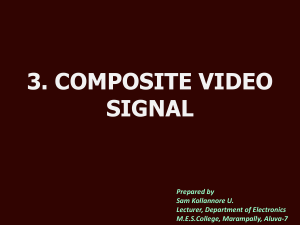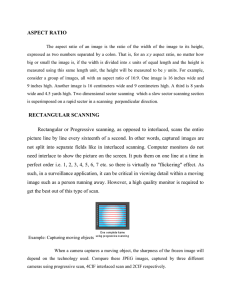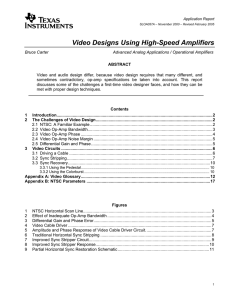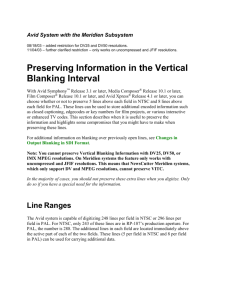Understanding Video Signal
advertisement
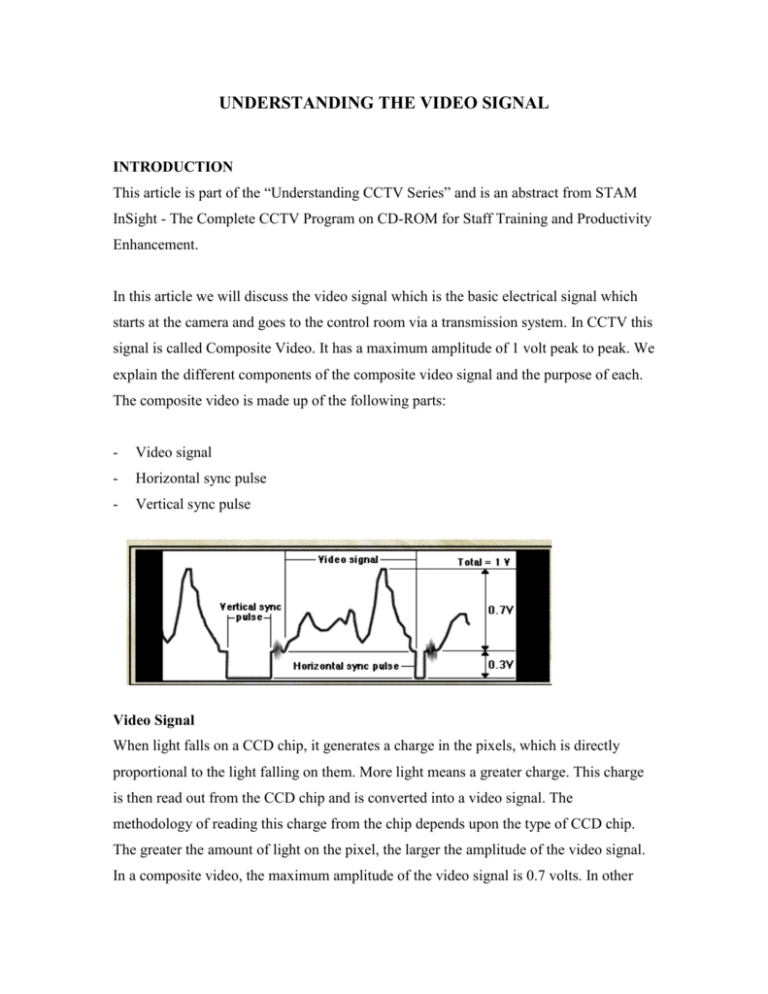
UNDERSTANDING THE VIDEO SIGNAL INTRODUCTION This article is part of the “Understanding CCTV Series” and is an abstract from STAM InSight - The Complete CCTV Program on CD-ROM for Staff Training and Productivity Enhancement. In this article we will discuss the video signal which is the basic electrical signal which starts at the camera and goes to the control room via a transmission system. In CCTV this signal is called Composite Video. It has a maximum amplitude of 1 volt peak to peak. We explain the different components of the composite video signal and the purpose of each. The composite video is made up of the following parts: - Video signal - Horizontal sync pulse - Vertical sync pulse Video Signal When light falls on a CCD chip, it generates a charge in the pixels, which is directly proportional to the light falling on them. More light means a greater charge. This charge is then read out from the CCD chip and is converted into a video signal. The methodology of reading this charge from the chip depends upon the type of CCD chip. The greater the amount of light on the pixel, the larger the amplitude of the video signal. In a composite video, the maximum amplitude of the video signal is 0.7 volts. In other words, the white or the bright part of the picture will have a signal strength of 0.7 volts, while the black or dark parts will have a signal of 0 volts. Vertical Sync Pulses. A video picture is made up of video frames. In NTSC there are 30 frames per sec, while PAL has 25 frames per sec. To avoid picture flickering in CCTV, this video frame is divided into 2 fields i.e. odd and even fields. These two fields are separated out at the camera point and then combined once again at the monitor end. This is also called interlacing of fields. At the end of each frame or field, a vertical sync pulse is added. This sync pulse tells the electronic devices in the camera and other CCTV component that the field has come to an end and gets them ready to receive the next frame or field. The duration of the pulse depends upon the time the electronic devices take to receive the next field. The amplitude of this pulse is a 0.3 volts. This when added to the video signal, gives a total amplitude of 1 volt peak to peak. Horizontal Sync Pulse A video frame is made of lines. . In NTSC there are 525 lines per frame, while PAL has 625 lines per frames. Each point in the line reflects the intensity of the video signal. At the end of each line, a horizontal sync pulse is added. This sync pulse tells the electronic devices in the CCTV system that a line has come to an end and to get ready for the start of the next line. This also has a amplitude of 0.3 volts. The above is a quick overview of the components of a composite video. Below are some statistics and additional information about a video signal. Horizontal and Vertical Scanning Frequencies The following table details the different frequencies under the PAL and NTSC system NTSC PAL Frame Frequency 30 per sec 25 per sec Duration of each frame 1/30 sec 1/25 sec No of fields per frame 2 2 Field frequency 60 per sec 50 per sec Duration of each field 1/60 sec 1/50 sec No of lines per frame 525 625 No of lines per field 262.5 312.5 No of lines per sec 525 X 30 = 625 X 25 = 15750 15625 1/15750 sec or 1/15625 sec or 63.5 us 64 us Duration of each line Horizontal and Vertical Blanking Retrace or fly back is the time required to move from the end of one line to the start of the next line or from the end of one field to the start of the next field. No picture information is scanned during the retrace and therefore must be blanked out. In television blanking means " going to black level". The retrace must be very rapid, since it is wasted time in terms of picture information. The time needed for horizontal blanking is approximately 16% of each horizontal line. The time for the vertical blanking is approximately 8% of the vertical field. Field duration NTSC PAL 1/60 sec 1/50 sec Vertical blanking 1/60 * .08 = 1333 us 1/50* .08 = 1600 us Line loss due to vertical 1333/63.5 = 21 lines 1600/64 = 25 lines Line duration 63.5 us 64 us Horizontal blanking 63.5 * .16=10.2 us 64 * .16=10.25 us Visible trace time 53.3 us 53.75 us blanking Horizontal and Vertical Synchronization The blanking pulse puts the video signal at the black level, the synchronization pulse starts the actual retrace in scanning. Each horizontal sync pulse is inserted in the video signal within the time of the horizontal blanking pulse and each vertical sync pulse is inserted in the video signal within the time of the vertical blanking time. The following is the frequency of each synchronization pulse. NTSC PAL Vertical 60 Hz 50 Hz Horizontal 15750 Hz 15625 Hz The Color Signal A color video signal is the same as monochrome except that the color information in the scene is also included, which is transmitted separately. The following two signals are transmitted separately 1. Luminance signal: known as the Y signal, it contains the variations in the picture information as in a monochrome signal and is used to reproduce the picture in black and white. 2. Chrominance signal: known as the C signal, it contains the color information. It is transmitted as the modulation on a sub carrier. The sub carrier frequency is 3.58 MHz for NTSC and 4.43 MHz for PAL. In a color receiver, the chrominance signal is recovered and combined with the luminance signal to give a color picture. In a monochrome receiver, the chrominance signal is not used and the picture is reproduced in black and white. Construction of the Composite Video Signal The composite video has the following parts: - Camera signal output corresponding to the variation of light in the scene - The sync pulses to synchronize the scanning - The blanking pulses to make the retrace invisible - For color signals, the chrominance signal and color sync burst are added. About the author Jayant Kapatker, President, STAM Multimedia Inc. Jayant has 15 years experience in the CCTV industry and recently moved to the USA. In 1997, he developed STAM InSight.- The Complete CCTV Program on CD-ROM for Staff Training and Productivity Enhancement. This article is part of this CD-ROM. Jayant is a popular CCTV trainer and conducts CCTV seminars all over the world. Currently his “Understanding CCTV Series’” is being published in 13 countries. For more details contact tel: +1 609 750 9827, fax: +1 609 750 1936, email: stammedia@aol.com. web: www.stamcctv.com
